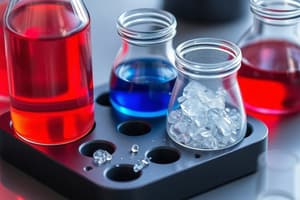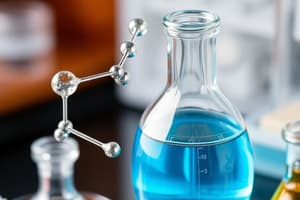Podcast
Questions and Answers
When reacting Al(OH)3 with NaOH and H2O2, the ______ will dissolve while the ppt of Fe(OH)3 will not be dissolved.
When reacting Al(OH)3 with NaOH and H2O2, the ______ will dissolve while the ppt of Fe(OH)3 will not be dissolved.
ppt of Al(OH)3 and Cr(OH)3
In the test for Fe+3, adding NH4SCN results in a ______ color.
In the test for Fe+3, adding NH4SCN results in a ______ color.
blood red
The yellow ppt formed when testing for Cr+3 occurs after adding ______ until acidity.
The yellow ppt formed when testing for Cr+3 occurs after adding ______ until acidity.
diluted acetic acid
When testing for Al+3, a white gelatinous ______ is produced after adding NH4Cl and boiling.
When testing for Al+3, a white gelatinous ______ is produced after adding NH4Cl and boiling.
The ppt of Fe(OH)3 formed during the reactions appears as ______ in color.
The ppt of Fe(OH)3 formed during the reactions appears as ______ in color.
A cation is a positive charge ______.
A cation is a positive charge ______.
Group II A cations include ______, Hg, Cd, and Bi.
Group II A cations include ______, Hg, Cd, and Bi.
The precipitating reagent for Group II A cations is ______ + H2S.
The precipitating reagent for Group II A cations is ______ + H2S.
Canary yellow ppt indicates the presence of ______ in Group II A cations.
Canary yellow ppt indicates the presence of ______ in Group II A cations.
The brown ppt observed belongs to ______ in Group II A cations.
The brown ppt observed belongs to ______ in Group II A cations.
Black ppt indicates the presence of ______ or Cu+2.
Black ppt indicates the presence of ______ or Cu+2.
To identify the cations, one may use dil. ______ and dil. H2SO4.
To identify the cations, one may use dil. ______ and dil. H2SO4.
Cations from Group III include Al+3, Fe+3, and ______.
Cations from Group III include Al+3, Fe+3, and ______.
1ml c.HCl + 2dps H2O2 will yield the ______
1ml c.HCl + 2dps H2O2 will yield the ______
If a white ppt is formed, it indicates the presence of ______
If a white ppt is formed, it indicates the presence of ______
The reagent used to precipitate group III cations is ______ OH.
The reagent used to precipitate group III cations is ______ OH.
From the solution containing Cu+2, a ______ solution is observed.
From the solution containing Cu+2, a ______ solution is observed.
To identify Cd+2, the solution must be combined with ______ acid and 1 dp K-ferrocyanide.
To identify Cd+2, the solution must be combined with ______ acid and 1 dp K-ferrocyanide.
When testing for Cr+3, a ______ precipitate is formed.
When testing for Cr+3, a ______ precipitate is formed.
If the solution does not dissolve after heating, ______ HCl should be added dropwise.
If the solution does not dissolve after heating, ______ HCl should be added dropwise.
The mixture of group III cations includes Fe+3, Cr+3, and ______.
The mixture of group III cations includes Fe+3, Cr+3, and ______.
Flashcards
Cation
Cation
A positively charged ion, represented by a symbol with a superscript plus sign.
Precipitating reagent
Precipitating reagent
A chemical that reacts with specific cations to form an insoluble precipitate, allowing for their separation and identification.
Precipitate
Precipitate
A solid, insoluble substance that forms during a chemical reaction, often used to identify specific ions.
Centrifugation
Centrifugation
Signup and view all the flashcards
Group analysis
Group analysis
Signup and view all the flashcards
Scheme for identification
Scheme for identification
Signup and view all the flashcards
Soluble
Soluble
Signup and view all the flashcards
Insoluble
Insoluble
Signup and view all the flashcards
Al(OH)₃ precipitate
Al(OH)₃ precipitate
Signup and view all the flashcards
Fe(OH)₃ precipitate
Fe(OH)₃ precipitate
Signup and view all the flashcards
Separation of Fe(OH)₃
Separation of Fe(OH)₃
Signup and view all the flashcards
Fe³⁺ test with NH₄SCN
Fe³⁺ test with NH₄SCN
Signup and view all the flashcards
Al³⁺ test with NH₄Cl
Al³⁺ test with NH₄Cl
Signup and view all the flashcards
Hg+2 Identification in Group II Cations
Hg+2 Identification in Group II Cations
Signup and view all the flashcards
Soluble Group II Cations
Soluble Group II Cations
Signup and view all the flashcards
Bismuth (Bi+3) Identification
Bismuth (Bi+3) Identification
Signup and view all the flashcards
Soluble Cations after NH3 Treatment
Soluble Cations after NH3 Treatment
Signup and view all the flashcards
Cadmium (Cd+2) Identification
Cadmium (Cd+2) Identification
Signup and view all the flashcards
Copper (Cu+2) Identification
Copper (Cu+2) Identification
Signup and view all the flashcards
Group III Cations List
Group III Cations List
Signup and view all the flashcards
Group III Precipitating Reagent
Group III Precipitating Reagent
Signup and view all the flashcards
Study Notes
Cations (Group IIA and Group III)
- Cations are positively charged ions. Represented as X⁺.
- Cations are classified into six groups based on the precipitating reagent used.
Group IIA Cations (Cu²⁺, Hg²⁺, Cd²⁺, Bi³⁺)
- The precipitating reagent is 0.25N HCl + H₂S.
- If a powder is not easily dissolved/ mixed with water, add concentrated HCl dropwise until it dissolves.
- Add an excess of H₂S to the mixture to create an insoluble precipitate.
- The resulting precipitate is analyzed for the presence of specific cations. This includes:
- Canary yellow ppt → Cd²⁺
- Brown ppt → Bi³⁺
- Black ppt → Hg²⁺, Cu²⁺
- A further test, using HNO₃, H₂SO₄ and hydrogen peroxide (H₂O₂) with concentrated HCl will distinguish the specific cation.
Group III Cations (Fe³⁺, Cr³⁺, Al³⁺)
- The precipitating reagent is NH₄OH (NH₃) + 10% NH₄Cl.
- Add concentrated HCl dropwise to the powder if it does not initially dissolve with water.
- Add NH₄Cl + NH₃ until the mixture becomes alkaline
- The resulting precipitate is further analyzed using different reagents:
- White gelatinous ppt → Al(OH)₃
- Reddish brown ppt → Fe(OH)₃
- Gray ppt → Cr(OH)₃
- If further analysis reveals a dissolved solution, further testing will differentiate between Al³⁺, Cr³⁺ and Fe³⁺ ions.
Centrifugation
- Centrifugation is a process used to separate particles of different densities in a mixture.
- Centrifuges spin at high speeds, causing heavier particles to settle to the bottom of the tube, creating a pellet.
- Lighter particles remain suspended above the pellet, which can be separated as a supernatant.
Studying That Suits You
Use AI to generate personalized quizzes and flashcards to suit your learning preferences.




